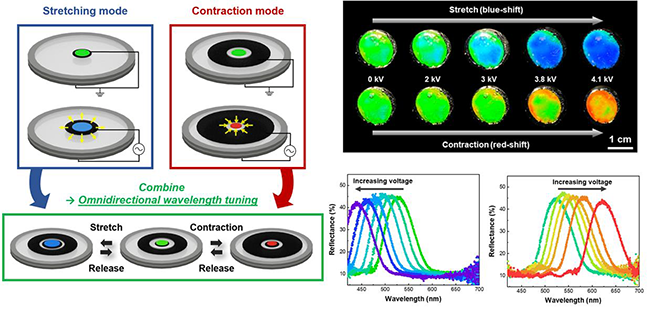Reviewed by Lexie CornerJun 4 2024
Researchers at Pohang University of Science and Technology (POSTECH), led by Professor Su Seok Choi and Ph.D. candidate Seungmin Nam, have achieved a breakthrough in photonics by developing a unique stretchable photonic device. This innovative device, detailed in a study published in Light: Science & Applications, can be used to control light wavelengths across all directions.
 Schematic representation of a flexible, stretchable photonic device capable of structural color tuning in both long and short wavelength directions. Image Credit: Pohang University of Science and Technology (POSTECH)
Schematic representation of a flexible, stretchable photonic device capable of structural color tuning in both long and short wavelength directions. Image Credit: Pohang University of Science and Technology (POSTECH)
Structural colors are created through the interaction of light with minute nanostructures, creating vibrant hues without the use of conventional color mixing techniques. While structural color technology utilizes the inherent wavelengths of light, conventional displays and image sensors combine the three major hues (red, green, and blue), producing more vibrant and varied color displays. This novel method is becoming acknowledged as a promising technological advancement in photonics and nano-optics.
Traditional color mixing techniques employ dyes or luminescent materials and are confined to passive and static color representation. In contrast, tunable color technology dynamically regulates nanostructures that correspond to certain light wavelengths, allowing pure colors to be freely adjusted. Previous research has mostly focused on unidirectional color tuning, often shifting colors from red to blue.
This change from blue to red, which has a longer wavelength, has been difficult to reverse. Current technology only allows for changes to shorter wavelengths, making it impossible to produce diversified color representation in the optimal free wavelength direction. As a result, a novel optical device capable of bidirectional and omnidirectional wavelength modification is required to maximize the utilization of wavelength control technology.
Professor Choi's team tackled these issues by combining chiral*1 liquid crystal*2 elastomers (CLCEs) with dielectric elastomer actuators (DEAs). CLCEs are flexible materials that can structurally alter color, whereas DEAs cause flexible deformation of dielectrics in response to electrical stimulation.
The researchers improved the actuator structure to allow for both expansion and contraction, combined it with CLCEs, and created a highly adjustable stretchy device. The device will enable users to freely alter the wavelength location over the visible spectrum (from shorter to longer wavelengths and vice versa).
In their studies, the researchers showed that their CLCE-based photonic device could use electrical stimuli to modulate structural colors throughout a wide range of visible wavelengths (from blue at 450nm to red at 650nm). This is a huge improvement over prior technologies, which were restricted to unidirectional wavelength adjustment.
This study not only defines a core technology for advanced photonic devices but also demonstrates its potential for various industrial applications.
This technology can be applied in displays, optical sensors, optical camouflage, direct optical analog encryption, biomimetic sensors, and smart wearable devices, among many other applications involving light, color, and further broadband electromagnetic waves beyond visible band. We aim to expand its application scope through ongoing research.
Professor Su Seok Choi, Department of Electrical Engineering, Pohang University of Science and Technology
The Korea Planning & Evaluation Institute of Industrial Technology’s Technology Innovation Program (Flexible Intelligent Variable Information Display) and Samsung Research Funding & Incubation Center of Samsung Electronics supported the study.